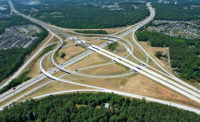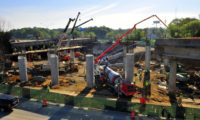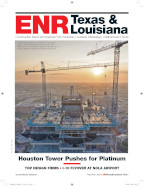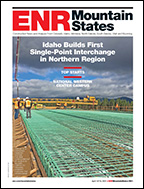North Carolina's sprawling upgrade of the Interstate 85/485 interchange near Charlotte, N.C., is proving that a bigger design can actually deliver significant cost savings.

Part of the North Carolina Dept. of Transportation's (NCDOT) program to fill the last six-mile gap in the 65-mile I-485 outer loop around Charlotte, the interchange uses a two-level "turbine" configuration rarely found in the U.S. Also called a "whirlpool" interchange, the design features swirling lanes that take left-turning traffic around a central bridge in a clockwise direction.
The design requires space for sweeping high-speed, high-capacity ramps. But what it takes up in acreage is made up for in construction efficiencies and cost savings. The projected price tag of $92.2 million is $30 million less than the four-level stacked interchange NCDOT originally envisioned.
The change was suggested during the design-build proposal process, says John Johnson, project director for the joint venture of STV and Ralph Whitehead Associates, which is teaming with Lane Construction for the project.
"We kept running into issues," Johnson says. Drawbacks to the stacked design included icing problems that frequently shut down another area interchange in winter, the need to erect girders as high as 80 ft and constraints on future expansion. The standard stacked design would also require two million cu yd of earthwork to support steep ramps and a long-term detour of I-85 traffic to local roads.
The project team reasoned that a turbine design could solve these problems, if space were available. And it was: NCDOT had acquired rights-of-way in the early 1990s for an earlier plan to construct a modified half-cloverleaf interchange. That concept called for two high-speed, high-capacity ramps with two tight loops.
"By replacing the smaller loops with two more high-capacity ramps to create the turbine design," Johnson says, "we made it work."
The turbine design requires 18 bridges, three times more than the stacked interchange, but their smaller sizes and simple single-span designs—including thinner columns, drilled piers, HP pile foundations and spread footings—will be easier to construct and maintain.
In addition, says NCDOT project manager Virginia Mabry, the more balanced distribution of earthwork, with borrow and fill locations across the project site, "reduces the amount of heavy trucking in a highly congested urban area, which means better traffic control for both the contractor and the public."
Even with its large footprint, the turbine's flexible ramp placement will result in fewer environmental impacts, including avoiding a vulnerable stream and preserving nearly 400 sq ft of habitat for the endangered Schweinitz sunflower.
The turbine interchange is expected to be complete by early June 2014 and will coincide with a seven-mile widening of I-85. That $125-million project, held by a design-build team of Lane and HDR Inc., will feature another uncommon design: a diverging diamond interchange, or DDI (ENR 12/21/09 p. 17). In a six-mile, $139-million contract, Blythe Construction and Wilbur Smith Associates also are building a DDI and revamping I-485/N.C. 115 with a split diamond interchange, in which traffic leaving the main highway is diverted to other routes via roundabouts. NCDOT estimates the three rare designs will save at least $50 million off the outer-loop program.






Post a comment to this article
Report Abusive Comment